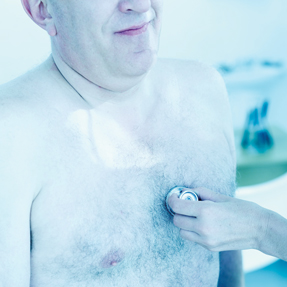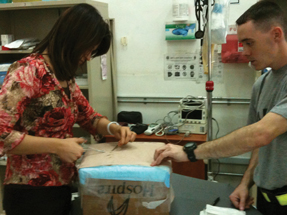Managing the elderly with cardiovascular disease
As patients are living longer, they're seeking more care for their cardiovascular diseases, as well as the accompanying comorbities such as diabetes. Effective therapy works in the older population, say the experts.
Cardiovascular disease affects most men and women as they move through their last several decades of life. Vessels become stiffer, collagen accumulates, smooth muscle cells migrate, vasomotor function declines, and the biology of the circulatory system is transformed.
Despite such inevitable cardiovascular changes, patients are living longer and, as they age, filling the offices of internal medicine practices. Over half the U.S. population can anticipate living past age 80, and care for these elderly patients involves special considerations, according to Daniel E. Forman, MD, a cardiologist and geriatrician at Harvard Medical School.

“Aging affects everything in an insidious way,” Dr. Forman said. “It is incumbent on us to think about how to manage these patients. Just as there are esteemed clinicians who might tell their older patients, ‘Well, you are just older, why bother,’ there are others who might push them to procedures for which benefits seem disproportionate. In either case, we have physicians who could be better trained to address the complexities inherent in their oldest patients.”
To improve physicians' preparation, Dr. Forman and other experts offered advice on optimizing cardiovascular care for these vulnerable patients.
Complexity of comorbidities
The most complicating factor in treatment decisions for older adults who have either subclinical or clinical cardiovascular disease is the presence of comorbidities. Aging adults not only have an increased prevalence of coronary risk factors and coronary artery disease, they also are more likely to have cerebrovascular disease, peripheral arterial disease (PAD), congestive heart failure, chronic kidney disease, atrial fibrillation, chronic obstructive pulmonary disease, arthritis, dyslipidemia, hypertension and diabetes, said Wilbert S. Aronow, MD, an ACP Fellow and clinical professor of medicine at Westchester Medical Center/New York Medical College.
The good news is that despite older adults' greater prevalence of cardiovascular disease, they also benefit from a greater reduction in absolute cardiovascular events with effective therapy, Dr. Aronow said. “So although elderly patients are less likely to be treated with effective therapies, you would get a greater absolute reduction in cardiovascular events from treating the elderly than treating younger patients.”
Dr. Aronow, who co-chaired the writing committee for the American College of Cardiology Foundation/American Heart Association (ACCF/AHA) 2011 Expert Consensus Document on Hypertension in the Elderly, said that hypertension is a comorbidity that continues to be undertreated in the elderly, even though it can lead to significant clinical events, such as stroke, myocardial infarction, heart failure, PAD and atrial fibrillation. Uncontrolled hypertension also increases risk of sudden cardiac death, angina pectoris and vascular dementia, among other conditions.
Blood pressure is adequately controlled in only 36% of men and 28% of women aged 60 to 79, and in 38% of men and 23% of women aged 80 and older. Cardiovascular therapies, including those for hypertension, can be the same for both men and women, but women continue to be treated with fewer effective therapies, Dr. Aronow said.
Physicians are often reluctant to prescribe medications for hypertension because their elderly patients are already taking multiple drugs or because of the potential for drug-drug and drug-disease interactions. These interactions must be considered when treating hypertension in the elderly, but they should not be used as a reason not to treat, given that hypertension leads to organ damage and clinical events, he said.
Even though hypertension trials historically have not included elderly patients, the Hypertension in the Very Elderly Trial (HYVET) showed that antihypertensive therapy benefits people over the age of 80. That trial, published in the New England Journal of Medicine in 2008, found that hypertensive therapy in people aged 80 and older leads to a 30% reduction in stroke, a 23% reduction in cardiovascular death, a 64% reduction in heart failure, and a 21% reduction in all-cause mortality.
Several medications are appropriate for elderly patients with hypertension, including angiotensin converting enzyme (ACE) inhibitors, beta-blockers, angiotensin receptor blockers (ARBs), diuretics, and calcium-channel blockers. “The important thing is to treat these patients. It is much more cost-effective to treat hypertension and other modifiable risk factors than to treat cardiovascular events,” Dr. Aronow said.
Elderly patients should be cautioned about using over-the-counter NSAIDs, he said, because those agents can increase blood pressure, interfere with the action of many drugs for hypertension, precipitate and aggravate heart failure, induce acute renal failure in patients with heart failure and chronic renal impairment, and cause cardiovascular events.
Dr. Aronow and the ACCF/AHA consensus document give several tips for evaluating hypertension in older patients:
- Take at least three different blood pressure measurements on two different office visits.
- Two of those measurements should be obtained after the patient has been seated comfortably for at least five minutes with the back supported, feet on the floor, and arm supported in horizontal position, with the blood pressure cuff at heart level.
- Take a blood pressure measurement with the patient standing for one to three minutes, particularly after a meal, to evaluate for postural hypotension or hypertension.
- The older the patient, the more likely that PAD is present, so it is important to take an ankle brachial index (ABI). Diagnose PAD if the ABI is less than 0.90 or 1.4 and higher.
- Target systolic blood pressure is =140/90 mm Hg in patients aged 55 to 79; a systolic blood pressure of 140 to 145 mm Hg, if tolerated, can be acceptable for those older than 80.
Diabetes
Diabetes is a primary factor in turning silent cardiovascular disease into clinical disease, according to Joshua Barzilay, MD, an ACP Fellow and endocrinologist at Kaiser Permanente of Georgia and a clinical professor of medicine at Emory University.
“In people with diabetes, the strongest risk factor for clinical cardiovascular disease is the presence of subclinical atherosclerotic disease,” he said. It is not yet clear, however, how or when diabetes converts subclinical atherosclerosis into clinical disease, but several theories are being explored.
According to Dr. Barzilay, blood sugar may begin to do “its dirty work” early on when glucose levels are not yet in the diabetic range. People with impaired glucose status (impaired fasting glucose or impaired glucose tolerance) have an approximately 25% to 35% increased risk of heart attacks as compared to people without such conditions. This risk increases as glucose rises into the diabetic range. The elevated glucose levels start a cascade of inflammatory processes in the blood vessel wall that initiate plaque buildup. Further inflammation leads to plaque rupture and a clinical cardiovascular event.
Research published in Diabetes Care in 2006 in a cohort of adults aged 65 years and older who had newly diagnosed diabetes and who were followed for up to 11 years found that diabetes was associated with a 90% increase in risk of all-cause mortality and a 120% increased risk of cardiovascular mortality compared with similarly aged individuals without diabetes.
Another theory of how diabetes leads to clinical cardiovascular disease is that blood sugar may be a marker of oxidative stress or the inflammatory processes in the vessel wall. In other words, the elevated sugar per se is not the culprit, but rather it is the downstream effect of the glucose in the arterial wall that leads to plaque rupture. The TINSAL-T2D Study is now looking at lowering oxidative stress and plaque buildup in the coronary arteries with salsalate, an anti-inflammatory drug that is used to treat arthritis, Dr. Barzilay said.
For now, as these innovative drugs are still being investigated, elderly people with diabetes can be treated with the same drugs as younger patients, Dr. Barzilay advised, although any decision about medication must be based on other comorbidities.
Metformin, for example, should be prescribed with caution in people with renal disease, although it can be safely used in patients with kidney disease up to stage 3. Insulin glargine may be a better choice than a sulfonylurea to lower glucose for an elderly patient because of its slower release action. Also, “You are not trying to reach a perfect blood sugar in the elderly; rather you want to keep it at 150 to 180 or 150 to 200,” Dr. Barzilay said. The recent results of the ACCORD study bear this out.
“The bottom line is that with older people, moderate lowering of glucose, blood pressure, and lipids works better than trying to be aggressive,” he said. “Moderation is the word to remember.”
The highest percentage of people who have a glucose disorder, be it prediabetes or diabetes, is in the elderly. They should be treated because it will keep their blood vessels as healthy as possible and maintain their quality of life, said Dr. Barzilay.
Concerns of elderly patients
Living a longer life is certainly an important goal for elderly patients, noted Dr. Forman, but most are also concerned about their overall quality of life and independence. “Patients need to be listened to. They are concerned about hospitalizations, the costs, the personal independence, the medication costs, the symptoms, interactions of medication, and the quality of their death.”
Complicating decision making, older patients often have the most to gain from pharmacological and interventional therapies, but they are also the most prone to iatrogenic risks and complications. For elderly patients, decisions about device therapy and invasive procedures are inherently complicated by aging dynamics, Dr. Forman said.
For example, he continued, an implantable cardioverter defibrillator may seem a reasonable option for an older patient, particularly because they are vulnerable to many pathologies associated with sudden cardiac death. However, that device then inadvertently dictates basic patterns at the end-of-life, and for some seniors this can even mean living a “hellish existence” as they become prone to increasing shocks in the midst of end-stage diseases.
“The devices are great in certain patients, but the decision to implant requires much careful thinking” since long- term implications can be profound, he said.
Recent research has reported that even in very elderly patients (aged 85 and older) with acute coronary syndrome and multi-vessel coronary artery disease, coronary artery bypass grafting (CABG) can be successful and may offer a significant survival advantage, Dr. Forman said. However, such theoretical benefits are counterbalanced by the high prevalence of cognitive decline, arthritis, breathing limitations, and elements of frailty that will almost certainly impact outcomes.
Treatment choices for these patients, such as whether to undergo CABG or device implantation, require clinical decision making that considers counterbalancing concerns and finds optimal solutions that are personalized for each patient, he said.
“Our older patients take more time, they are more complicated. ... We are dealing more and more with the fact that cardiac and noncardiac morbidities are associated with each other, and that both aggressive and nonaggressive management strategies are important. It is important to think through the decisions with your patients and not just make assumptions,” said Dr. Forman.
Ideally, the results of these decisions will be a much better quality of life. “You might say that for a patient who is already 65 or 70 and has been exposed to 65 to 70 years of risk factors, it is too late to do anything. The answer is that it is most likely not too late,” Dr. Barzilay said. “People of age 70 today are not really old, although they may need a roto-rooter job or a cleaning out here and there. But unless they have Alzheimer's, most people that age are well. You can help them gain a lot of productivity and quality of life by treating them.”





